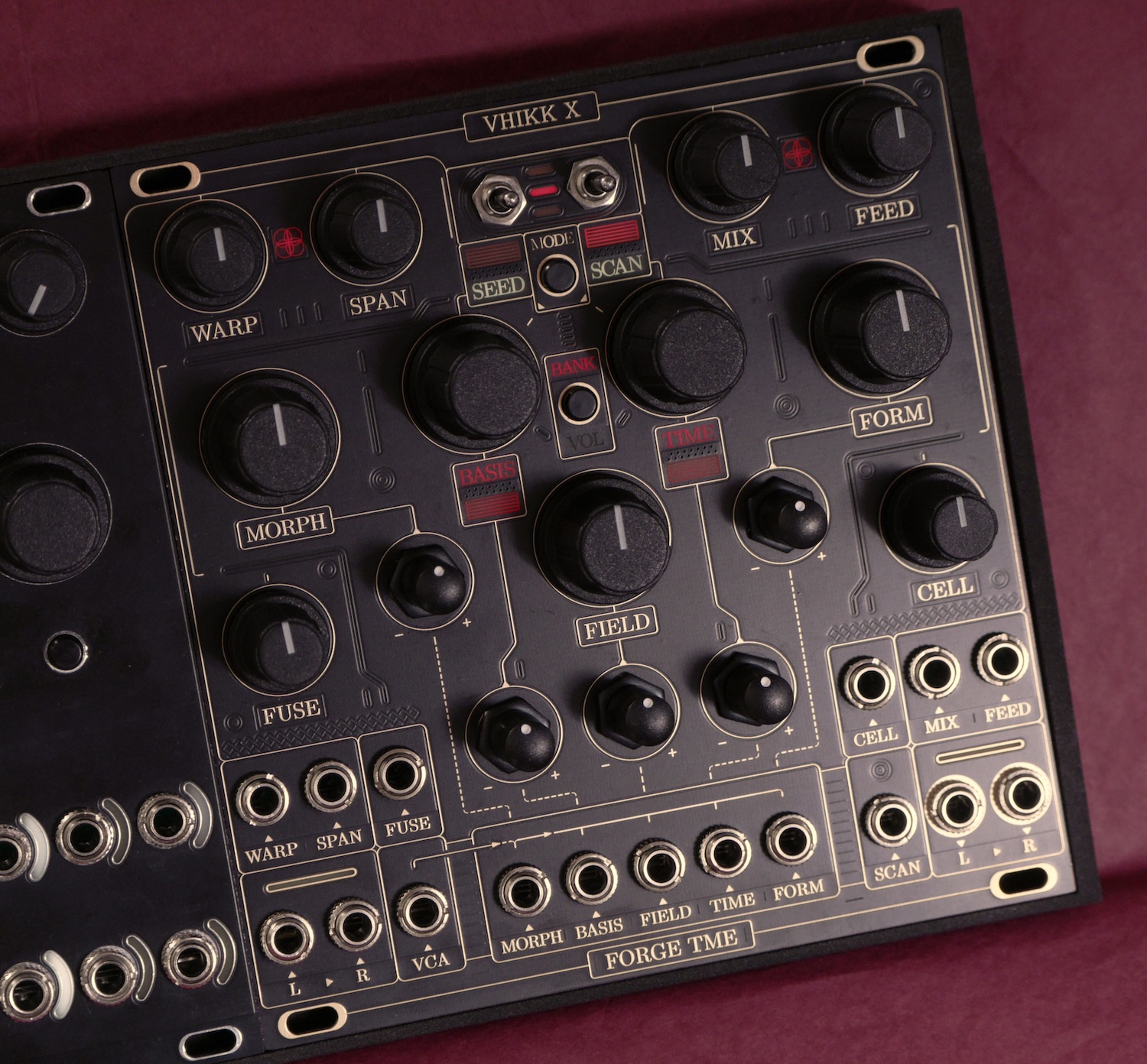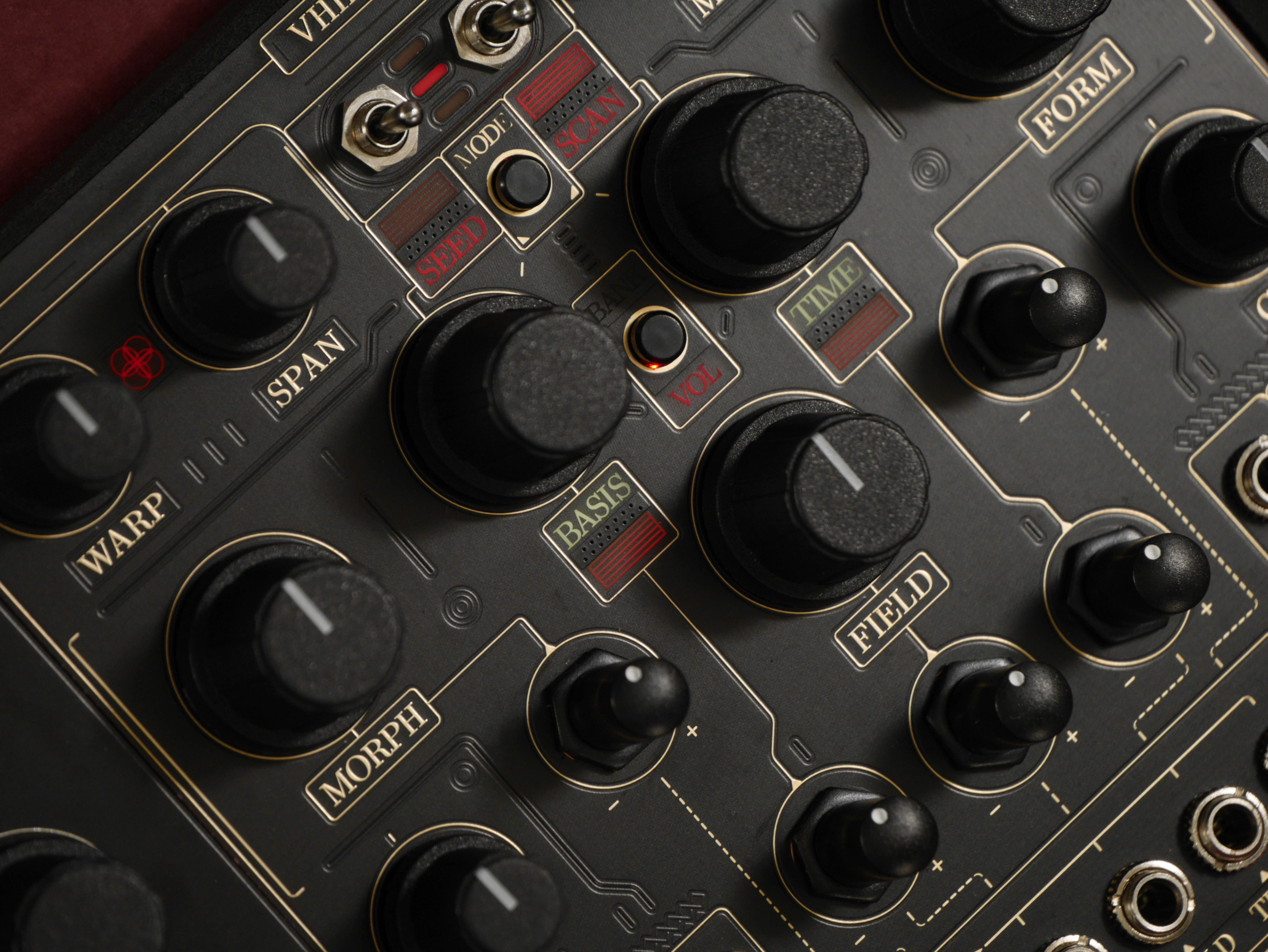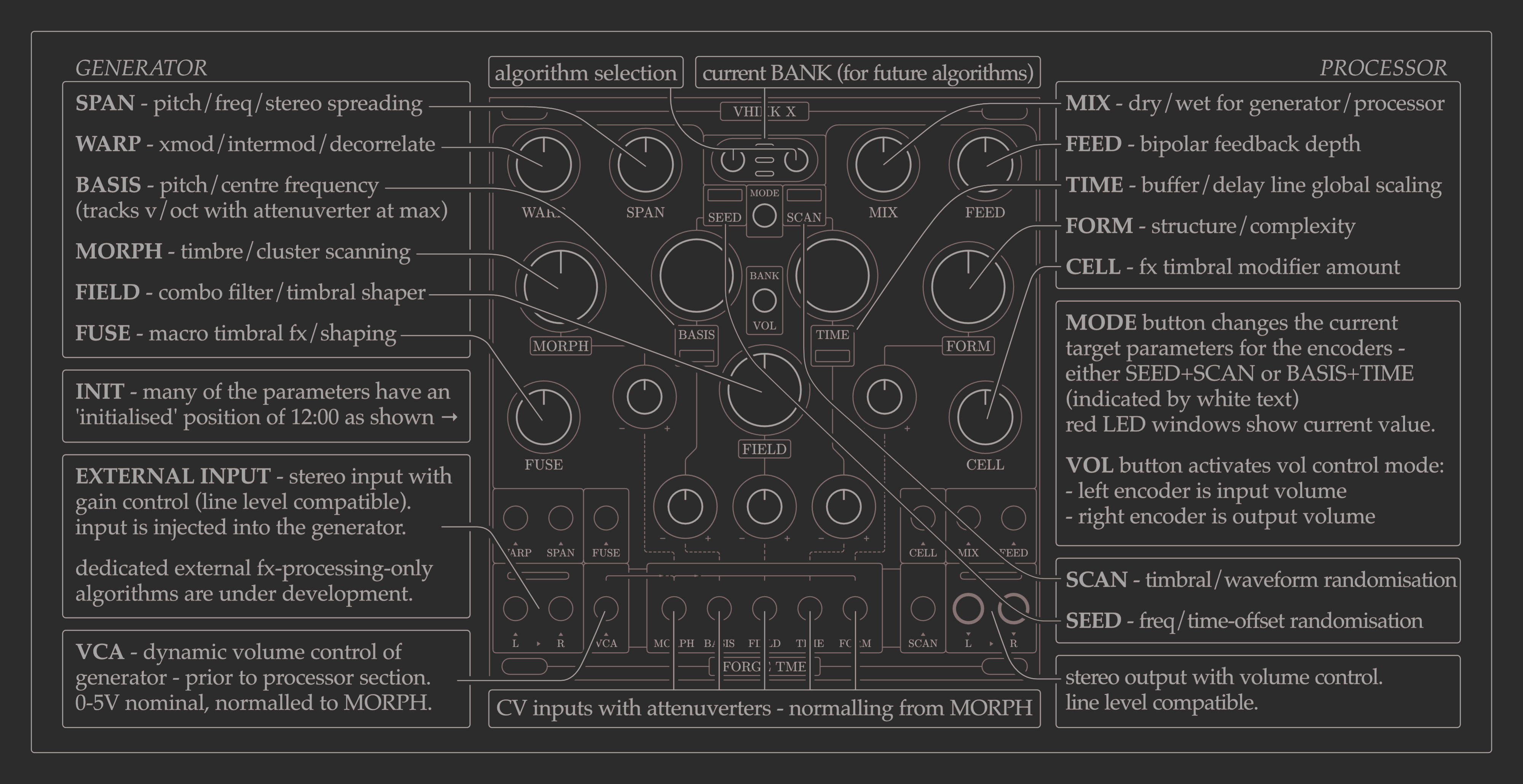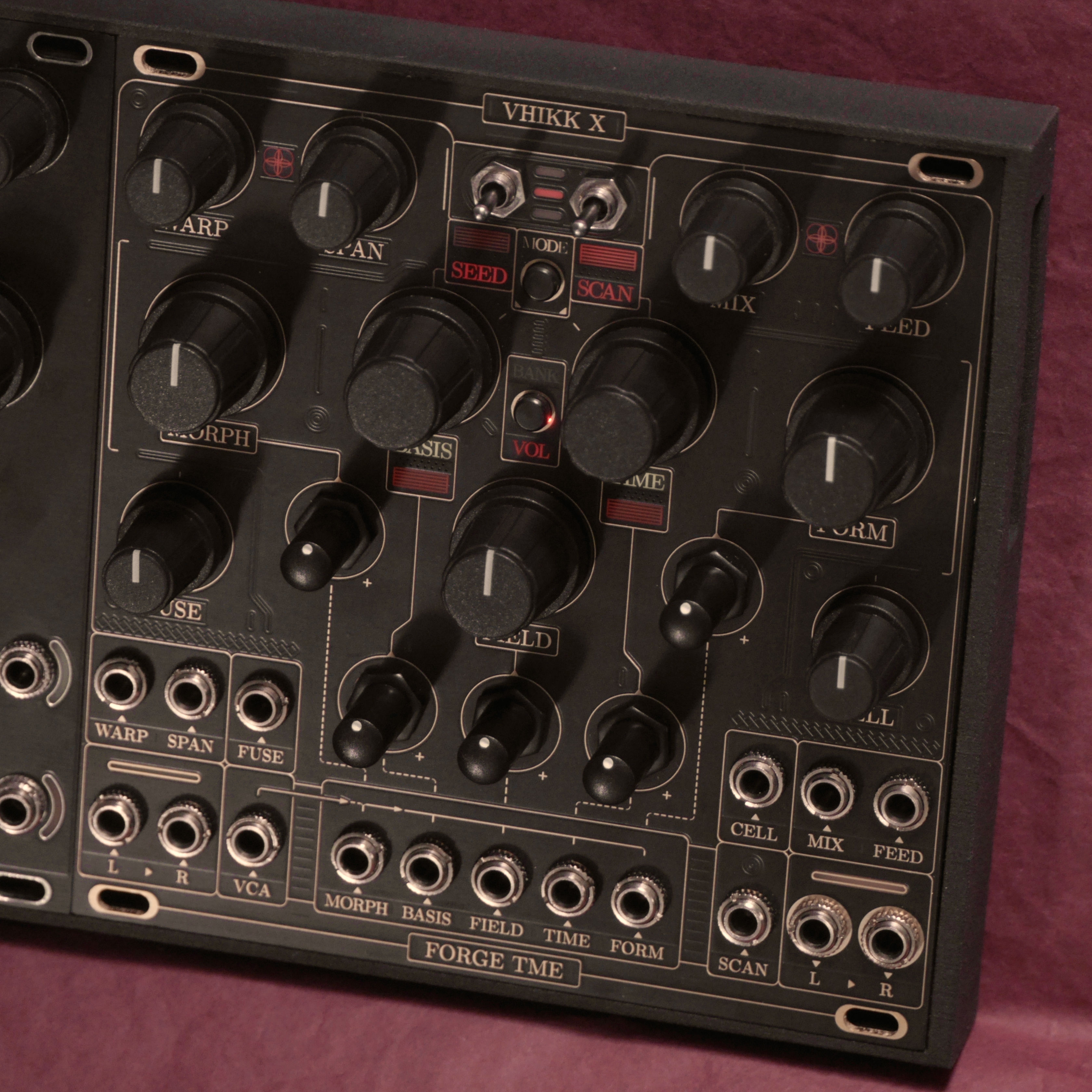 VHIKK X
VHIKK X 

news
- last updated oct 24 2025 -
The current batch is being manufactured and shipped out to stores weekly right now.
If stores don't receive enough from this batch to fulfill all of their preorders, some people will have to wait until the next batch in January
(possibly kicking off in Dec if parts arrive a bit early).
The next batch will be very big so all preorders should be filled and hopefully there will finally be some in stock!
I'll announce news and updates, and the eventual release of the new algorithms here, on instagram and on the modwiggler thread.
Once the new firmware has been released, I'll compile diagrams, patch notes, FAQs and algorithm summaries into a pdf manual, but for now this webpage will serve as the definitive user guide.
The Glasgow Synth Guild are manufacturing Vhikk X, with Signal Sounds handling international distribution.
Get in touch at contact@forge-tme.com if you have any specific questions.
ordering
The current retailers carrying VHIKK X are:
Signal Sounds
Found Sound
SchneidersLaden
Perfect Circuit
Nightlife Electronics
Elevator Sound
Synthshop.no
Boutique Pedal NYC
MIDI Amsterdam
Rubadub
Detroit Modular
Escape From Noise
Control Voltage
Moog Audio
Synthesizer.gr
overview
A sound demo video can be found
here.
Vhikk X on Modulargrid
- - - -
The vhikk twists, convulses and wails in a vortex haunted, spitting dirt and dust and time and
raw energy.
Rapid shadows, alien physics, pulsating artefacts, sometimes ridiculous, sometimes possessed.
A window to an alternate reality. Engine room communications network phreak, phase splitting in the teardrop orbifold.
The vhikk is a multi-algorithm sound source and processor capable of traversing sonic planes
complex, raw, dense, electric, erratic, dynamic.
The vhikk trades standard control and comprehensions for a [hopefully fertile]
dialogical experience and breadth of sonic palette.
It is designed to encourage exploration and [tele]presence - with low cognitive overhead.
The vhikk rewards lateral theory and lateral practice, with its own unique operational modes and interwoven parameterisations.
The vhikk is happy alone but thirsty for voltages.
The produced output can be quite spectrally and temporally full and doesn't necessarily require
[but certainly appreciates] further processing to synthesise musically/experientially useful material.

Vhikk X is a multi-algorithm experimental synthesis coalescence specialising in [but not limited to] complex drones/basses, rich textures, dynamic sfx, and warped signal processing.
It combines sound generation and effects processing into one module with multiple different algorithms.
The nature of Vhikk X makes it suitable for situations where a compact, ergonomic, and self-contained sound source/processor would be welcome -
for example smaller modular systems, or large systems where a self-contained sound island with minimised cognitive overhead would be desirable.
Each combined position of the two toggle switches is a different algorithm, giving 9 in total per bank.
There are 4 banks as indicated by the 3 red lights between the toggle switches, giving 36 total algorithms.
Vhikk X expands on the original Vhikk technically and ideologically by offering more parameters, more algorithms, more CV inputs,
and continuous control over architectural morphing and internal randomisation
- all while retaining the ergonomy and interactive experience of Vhikk V1.
Vhikk X also introduces:
24bit inputs and outputs
stereo inputs for audio processing
VCA input for amplitude shaping without requiring an external stereo VCA
Continuous control of input/output volumes with soft clipping and lots of gain on tap to drive next-in-chain modules and boost lower level input signals.
[can also take line level in and produce line level out]
The improved signal path allows for Vhikk X to expand into cleaner and more dynamic sonic territory, while still providing means to
twist and crush itself into dirty saturated mayhem. There have also been stereo imaging improvements, with algorithm tweaks to run in true stereo end-to-end.
Vhikk X has the ability to do firmware updates via the USB-C port on the side, supporting USB Mass Storage drag and drop.
how to use
---- power, io ----
The Vhikk X power connection is side-entry with a cutout in the main circuit board for cable clearance. Ensure the red stripe [-12V] is closest to the 'RED' label on the rear of the circuit board [red stripe down as viewed from behind]. The power input is reverse polarity protected.
The USB port is for firmware updates only, Vhikk X requires a standard eurorack power supply.
Vhikk X has stereo outputs on the bottom right labeled L/R for left/right. The L output is normalled to the R output so patching a single cable from R will provide a mono sum.
The stereo inputs at bottom left are normalled together, so patching a signal into a single input [either L or R] will work for mono signals.
The long LED windows above the input and output jacks are for level-monitoring and display their respective signal levels - white for left [L], red for right [R].
The signal path for the audio inputs is algorithm-dependent and is detailed in the algorithm reference.
---- encoders ----
In addition to the parameters present on the fixed-function knobs, the two central encoders can target a number of different parameters dependent on the current MODE.
The active encoder target is denoted with white text labels, while the inactive labels glow red.
The most-used encoder target parameters [BASIS, TIME, SEED, SCAN] have associated light windows which give a visual representation of their current values.
The top button [MODE] will toggle between the two main encoder target states - BASIS + TIME, and SEED + SCAN.
The bottom button's function is dependent on the current encoder target state:
- When the encoders are targetting BASIS + TIME - the bottom button engages encoder volume [VOL] control.
- When the encoders are targeting SEED + SCAN - the bottom button changes the currently selected BANK.
- [Note: the early firmware versions only contains a single bank of algorithms, so BANK selection is disabled until future firmware updates]
---- firmware v003 and above feature:
When in normal operation (not in calibration or state-saving mode as described below), press both buttons to internally randomise SEED and SCAN.
----
In volume control mode [VOL], the left encoder controls input volume, while the right encoder controls output volume. The text labels are disabled, since the lower LED windows are used to show current in/out volume levels and the upper LED windows are in/out clipping indicators.
The volume gain ranges are detailed in the specifications below, but are suitable for use with many different signal levels, both in Eurorack systems and directly with line level equipment.
The signal path has plenty of headroom and is designed to soft-clip at each gainstage.
---- state saving ----
The encoder-targeted parameters are all saved internally to retain their values through power-cycles. There is an internal delay for wear-levelling, so any parameters which are unchanged for approximately 30 seconds are saved.
SEED and SCAN are saved per-algorithm, and volume levels [VOL] are saved globally. BASIS and TIME can be selectively saved either globally or per-algorithm.
Hold down the top button [MODE] while powering on the module to enable global saving. Alternatively, hold down the bottom button while powering on to enable per-algorithm saving.
Global saving is intended for situations where it is convenient to retain e.g. tuning and synchronised delay times across different algorithms, while per-algorithm saving allows for each algorithm to retain its own copy of these parameters.
---- firmware v003 and above feature:
To change the BASIS/TIME save mode while the module is in use:
- Hold the top button for approx 5 seconds
- You will enter param-save-mode with both LOGOs blinking
- The rest of the module will behave as normal (sound doesn't cut out)
- Top button selects GLOBAL BASIS/TIME saving
- Bottom button selects PER_ALGO BASIS/TIME saving
- Press both buttons to save and exit this mode
- The current algo will reset with the new setting
----
This selection will be remembered until the next time it is changed. Per-algo saving is enabled by default.
---- vca, cv normalling ----
The CV input ranges are detailed in the specifications section below. The 5 CV inputs in the bottom centre have their own associated attenuverters, while the remaining CV inputs are summed with the value set by their associated panel control.
The VCA input targets an internal stereo VCA for amplitude control without requiring an external stereo VCA. This also allows for the VCA to e.g. be placed before delay/reverb sections.
The location of the VCA in the signal path is algorithm dependent and is detailed in the algorithm reference.
With nothing patched to the VCA input, an offset equivalent to +5V is present. A +5V external CV will open the VCA fully - voltages above this will overdrive whatever is following the VCA in the signal path.
The VCA input and the CV inputs with attenuverters have software controlled normalling to allow for flexible CV control even with minimal physical patching.
If a CV is patched into the VCA input, it will be normalled to the 5 other jacks [MORPH, BASIS, FIELD, TIME, FORM] which will then pass through their respective attenuverters.
If a CV is patched into the MORPH input, it will be normalled to the 4 other inputs [BASIS, FIELD, TIME, FORM], overriding the above normalling.
If nothing is patched to both VCA and MORPH, a small offset will be normalled to MORPH, BASIS, FIELD, TIME and FORM to allow the use of the attenuverters as fine-tune controls.
All physically accessible parameters have CV inputs except for the volume controls and SEED - SEED is intended to be a very wide-ranging parameter designed for manual control. In testing, the VCA input proved more useful than a SEED CV input.
---- calibration ----
---- calibration is only available in firmware v003 and above ----
BASIS calibration:
- Hold the bottom button for approx 5 seconds
- You will enter calibration mode with the BASIS led blinking
- The rest of the module will behave as normal (sound doesn't cut out)
- The module will always be playing with the updated calibration values, so you can test the tracking while in calibration mode.
(Make sure the BASIS attenuverter is fully clockwise)
- Apply 1V to the BASIS input from the CV out of your desired V/Oct source.
(This should be C2 but consult your manual for the correct voltage/octave offsets)
- The left logo LED (between WARP and SCAN) will light up if you are within the correct range.
- Press the BOTTOM button to lock in the low value for calibration.
- If the current voltage is outside the correct range, the red LEDs will blink an error pattern and the value will be ignored.
- Apply 3V to the BASIS input from the CV out of your desired V/Oct source.
(This should be C4 but consult your manual for the correct voltage/octave offsets)
- The right logo LED (between MIX and FEED) will light up if you are within the correct range.
- Press the TOP button to lock in the high value for calibration.
- If the current voltage is outside the correct range, the red LEDs will blink an error pattern and the value will be ignored.
- Hold the top button for 5 seconds to mute the current algo and instead play a sawtooth wave.
(This could make it easier for an external module or e.g. an audio interface to lock onto the tuning for system-level calibration)
- Hold the bottom button for 5 seconds to reset the calibration to default values.
- Press both buttons to save the current calibration and exit back to normal mode.
back to contents
algorithm reference
These are external links to the algorithm reference pages for the various firmware versions.
To find your firmware version, attach Vhikk X to a computer via USB and open the HELP.TXT file.
Your firmware version will be noted in the diagnostics box as "fw.ver: ________".
00000001
00000002
00000003
- (same algorithms)

While the launch algos are similar in function to Vhikk V1, many of the upcoming algorithms are fundamentally different - and closer to the deeper identity which I've been trying to push towards with Vhikk.
There is this ideal which I'm aiming for.. entirely new parameterisations and signal structures - taking advantage of the abstract parameter names rather than them providing the cognitive load of maintaining an approximate mental 'vhikk parameter' to 'normal parameter' mapping. Something about categorical/etymological surfaces and imagining parallel planes of development/history.
I'm slowly getting there but I'm excited to eventually share the... final form.. of Vhikk X.
Exploring machine-trust, architectural morphing, alien radio channel-surfing, environmental synthesis, infrastructure and ultrastructure, etc.
specs
24HP, 15mm depth below panel [power header is side-entry with a cutout in the main PCB]
Current draw: +12V: 100mA, -12V: 10mA
The audio path and all processing runs at 96kHz. Audio inputs and outputs are 24bit. CV inputs are 16bit scanned at 24kHz.
CV/signal input voltage: 20Vpp - full param range clipped in software
A 5V swing corresponds to the full parameter knob range.
CV input impedance: 200kOhm
Audio input clips at 20Vpp, gain from -inf dB [silence] to +30dB
Audio input impedance: 30kOhm
Audio output voltage: 18Vpp full scale with volume control [which silences the output at minimum value]
Audio output impedance: 1kOhm
Reverse polarity protected
Both USB and Eurorack power can be connected concurrently

Vhikk X is covered under warranty for two years following the purchase date. The warranty covers any defect in the
manufacture of this product and does not cover any damage or malfunction caused by incorrect use - such as, but not
limited to, power cables connected incorrectly, excessive voltage levels, or exposure to extreme temperature or moisture levels.
The warranty covers replacement or repair, details about shipping and warranty applicability will be determined
upon contacting us at contact@forge-tme.com.